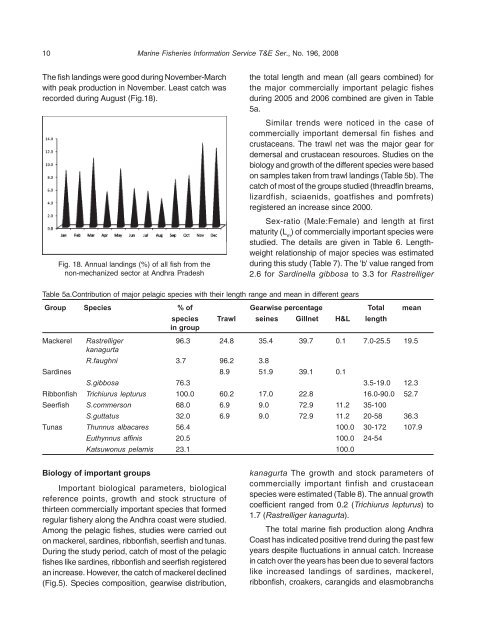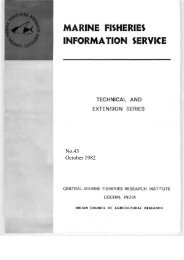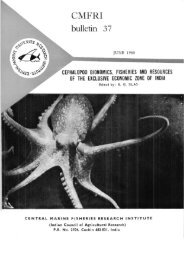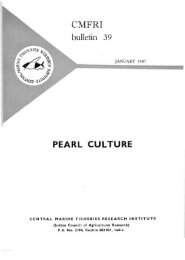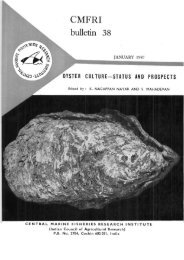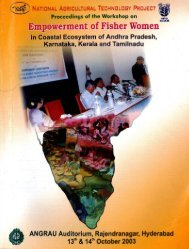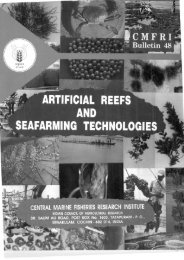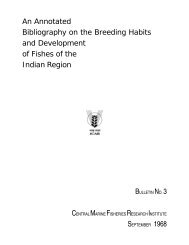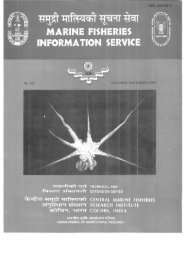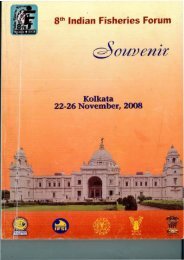Marine Fisheries Information Service - Eprints@CMFRI - Central ...
Marine Fisheries Information Service - Eprints@CMFRI - Central ...
Marine Fisheries Information Service - Eprints@CMFRI - Central ...
You also want an ePaper? Increase the reach of your titles
YUMPU automatically turns print PDFs into web optimized ePapers that Google loves.
10 <strong>Marine</strong> <strong>Fisheries</strong> <strong>Information</strong> <strong>Service</strong> T&E Ser., No. 196, 2008<br />
The fish landings were good during November-March<br />
with peak production in November. Least catch was<br />
recorded during August (Fig.18).<br />
Fig. 18. Annual landings (%) of all fish from the<br />
non-mechanized sector at Andhra Pradesh<br />
the total length and mean (all gears combined) for<br />
the major commercially important pelagic fishes<br />
during 2005 and 2006 combined are given in Table<br />
5a.<br />
Similar trends were noticed in the case of<br />
commercially important demersal fin fishes and<br />
crustaceans. The trawl net was the major gear for<br />
demersal and crustacean resources. Studies on the<br />
biology and growth of the different species were based<br />
on samples taken from trawl landings (Table 5b). The<br />
catch of most of the groups studied (threadfin breams,<br />
lizardfish, sciaenids, goatfishes and pomfrets)<br />
registered an increase since 2000.<br />
Sex-ratio (Male:Female) and length at first<br />
maturity (L m<br />
) of commercially important species were<br />
studied. The details are given in Table 6. Lengthweight<br />
relationship of major species was estimated<br />
during this study (Table 7). The 'b' value ranged from<br />
2.6 for Sardinella gibbosa to 3.3 for Rastrelliger<br />
Table 5a.Contribution of major pelagic species with their length range and mean in different gears<br />
Group Species % of Gearwise percentage Total mean<br />
species Trawl seines Gillnet H&L length<br />
in group<br />
Mackerel Rastrelliger 96.3 24.8 35.4 39.7 0.1 7.0-25.5 19.5<br />
kanagurta<br />
R.faughni 3.7 96.2 3.8<br />
Sardines 8.9 51.9 39.1 0.1<br />
S.gibbosa 76.3 3.5-19.0 12.3<br />
Ribbonfish Trichiurus lepturus 100.0 60.2 17.0 22.8 16.0-90.0 52.7<br />
Seerfish S.commerson 68.0 6.9 9.0 72.9 11.2 35-100<br />
S.guttatus 32.0 6.9 9.0 72.9 11.2 20-58 36.3<br />
Tunas Thunnus albacares 56.4 100.0 30-172 107.9<br />
Euthynnus affinis 20.5 100.0 24-54<br />
Katsuwonus pelamis 23.1 100.0<br />
Biology of important groups<br />
Important biological parameters, biological<br />
reference points, growth and stock structure of<br />
thirteen commercially important species that formed<br />
regular fishery along the Andhra coast were studied.<br />
Among the pelagic fishes, studies were carried out<br />
on mackerel, sardines, ribbonfish, seerfish and tunas.<br />
During the study period, catch of most of the pelagic<br />
fishes like sardines, ribbonfish and seerfish registered<br />
an increase. However, the catch of mackerel declined<br />
(Fig.5). Species composition, gearwise distribution,<br />
kanagurta The growth and stock parameters of<br />
commercially important finfish and crustacean<br />
species were estimated (Table 8). The annual growth<br />
coefficient ranged from 0.2 (Trichiurus lepturus) to<br />
1.7 (Rastrelliger kanagurta).<br />
The total marine fish production along Andhra<br />
Coast has indicated positive trend during the past few<br />
years despite fluctuations in annual catch. Increase<br />
in catch over the years has been due to several factors<br />
like increased landings of sardines, mackerel,<br />
ribbonfish, croakers, carangids and elasmobranchs


